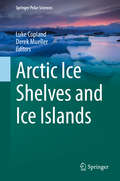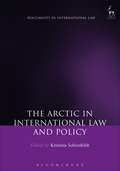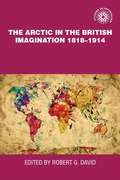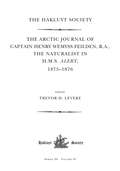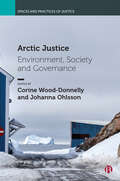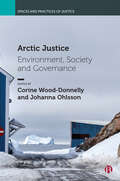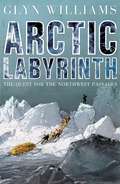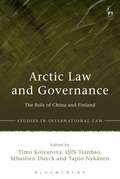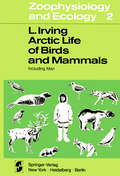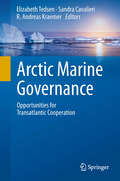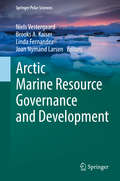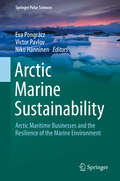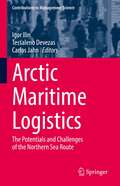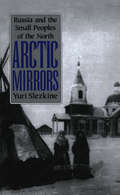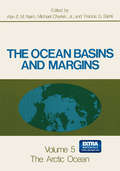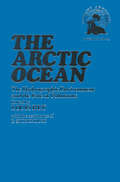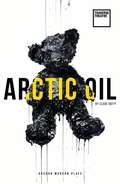- Table View
- List View
Arctic Ice Shelves and Ice Islands (Springer Polar Sciences)
by Luke Copland Derek MuellerThis book provides an overview of the current state of knowledge of Arctic ice shelves, ice islands and related features. Ice shelves are permanent areas of ice which float on the ocean surface while attached to the coast, and typically occur in very cold environments where perennial sea ice builds up to great thickness, and/or where glaciers flow off the land and are preserved on the ocean surface. These landscape features are relatively poorly studied in the Arctic, yet they are potentially highly sensitive indicators of climate change because they respond to changes in atmospheric, oceanic and glaciological conditions. Recent fracturing and breakup events of ice shelves in the Canadian High Arctic have attracted significant scientific and public attention, and produced large ice islands which may pose a risk to Arctic shipping and offshore infrastructure. Much has been published about Antarctic ice shelves, but to date there has not been a dedicated book about Arctic ice shelves or ice islands. This book fills that gap.
The Arctic in China’s National Strategy: Science, Security, and Governance (Rethinking Asia and International Relations)
by Martin KossaThis book locates the Arctic within the context of the People’s Republic of China’s (PRC) national strategy of the Great Rejuvenation of the Chinese Nation. Drawing on a range of sources published in Chinese and English, the author analyses Beijing’s Arctic scientific activities and technological capabilities, including the research infrastructure, long-term goals, and the significance for China’s understanding of the region, its Arctic identity, and international perceptions. Examining the region from the perspective of the Comprehensive National Security Outlook developed during the Xi Jinping era, the book focuses on military, economic, technological, and political components and considers the PRC’s official and academic discourses and the views of the region within bilateral relations with Arctic states, outlining a science, security, and governance nexus in China’s Arctic engagement. This volume will be of interest to scholars and students of Arctic geopolitics, Chinese studies, security studies, and foreign policy analysis. It will also appeal to policymakers and defence analysts in Arctic states and other regional stakeholders.
The Arctic in China’s National Strategy: Science, Security, and Governance (Rethinking Asia and International Relations)
by Martin KossaThis book locates the Arctic within the context of the People’s Republic of China’s (PRC) national strategy of the Great Rejuvenation of the Chinese Nation. Drawing on a range of sources published in Chinese and English, the author analyses Beijing’s Arctic scientific activities and technological capabilities, including the research infrastructure, long-term goals, and the significance for China’s understanding of the region, its Arctic identity, and international perceptions. Examining the region from the perspective of the Comprehensive National Security Outlook developed during the Xi Jinping era, the book focuses on military, economic, technological, and political components and considers the PRC’s official and academic discourses and the views of the region within bilateral relations with Arctic states, outlining a science, security, and governance nexus in China’s Arctic engagement. This volume will be of interest to scholars and students of Arctic geopolitics, Chinese studies, security studies, and foreign policy analysis. It will also appeal to policymakers and defence analysts in Arctic states and other regional stakeholders.
The Arctic in International Law and Policy (Documents in International Law)
by Kristina SchönfeldtThe Arctic is an increasingly important region faced with major challenges caused not only by the effects of climate change, but also by a growing interest in its living and non-living resources, its attraction as a new destination for tourism, and as a route for navigation. It is not only the eight Arctic States that have paid an increased level of attention to the region; several non-Arctic actors from Asia and Europe also seek to gain more influence in the High North. At the same time, the evolving law and policy architecture for the Arctic region has recently played a more prominent role in the political and academic debate. Unlike Antarctica, where the coherent Antarctic Treaty System governs international cooperation, the legal regime of Arctic affairs is based on public international law, domestic law, and 'soft law'. These three pillars intersect and interact making Arctic governance multi-faceted and highly complex.This book provides an analytical introduction, a chronology of legally relevant events, and a selection of essential materials covering a wide range of issues-eg delineation and delimitation of maritime boundaries, environmental protection, indigenous peoples' rights, shipping, and fisheries. Included are multilateral and bilateral treaties, UN documents, official statements, informal instruments, domestic laws, and diplomatic correspondence.
The Arctic in International Law and Policy (Documents in International Law)
by Kristina SchönfeldtThe Arctic is an increasingly important region faced with major challenges caused not only by the effects of climate change, but also by a growing interest in its living and non-living resources, its attraction as a new destination for tourism, and as a route for navigation. It is not only the eight Arctic States that have paid an increased level of attention to the region; several non-Arctic actors from Asia and Europe also seek to gain more influence in the High North. At the same time, the evolving law and policy architecture for the Arctic region has recently played a more prominent role in the political and academic debate. Unlike Antarctica, where the coherent Antarctic Treaty System governs international cooperation, the legal regime of Arctic affairs is based on public international law, domestic law, and 'soft law'. These three pillars intersect and interact making Arctic governance multi-faceted and highly complex.This book provides an analytical introduction, a chronology of legally relevant events, and a selection of essential materials covering a wide range of issues-eg delineation and delimitation of maritime boundaries, environmental protection, indigenous peoples' rights, shipping, and fisheries. Included are multilateral and bilateral treaties, UN documents, official statements, informal instruments, domestic laws, and diplomatic correspondence.
The Arctic in the British imagination 1818–1914 (Studies in Imperialism)
by Rob DavidThe Arctic region has been the subject of much popular writing. This book considers nineteenth-century representations of the Arctic, and draws upon an extensive range of evidence that will allow the 'widest connections' to emerge from a 'cross-disciplinary analysis' using different methodologies and subject matter. It positions the Arctic alongside more thoroughly investigated theatres of Victorian enterprise. In the nineteenth century, most images were in the form of paintings, travel narratives, lectures given by the explorers themselves and photographs. The book explores key themes in Arctic images which impacted on subsequent representations through text, painting and photography. For much of the nineteenth century, national and regional geographical societies promoted exploration, and rewarded heroic endeavor. The book discusses images of the Arctic which originated in the activities of the geographical societies. The Times provided very low-key reporting of Arctic expeditions, as evidenced by its coverage of the missions of Sir John Franklin and James Clark Ross. However, the illustrated weekly became one of the main sources of popular representations of the Arctic. The book looks at the exhibitions of Arctic peoples, Arctic exploration and Arctic fauna in Britain. Late nineteenth-century exhibitions which featured the Arctic were essentially nostalgic in tone. The Golliwogg's Polar Adventures, published in 1900, drew on adult representations of the Arctic and will have confirmed and reinforced children's perceptions of the region. Text books, board games and novels helped to keep the subject alive among the young.
The Arctic Incident: The Graphic Novel (Artemis Fowl Graphic Novels #2)
by Eoin Colfer Andrew Donkin Giovanni RiganoA stunning graphic-novel adaptation of the megaselling Artemis Fowl: The Arctic Incident.Adapted by Eoin Colfer and Andrew Donkin. Art by Giovanni Rigano and colour by Paolo Lamanna.Someone has been supplying Class-A illegal human power sources to the goblins. Captain Holly Short of the LEPrecon Unit is sure that her arch-enemy, thirteen-year-old Artemis Fowl, is responsible. But is he? Artemis has his own problems to deal with: his father is being held to ransom and only a miracle will save him. Maybe this time a brilliant plan just won't be enough. Maybe this time Artemis needs help . . .'Reads like the fastest, punchiest comic strip you've ever come across' - Daily Telegraph'Artemis is a brilliant creation' - Anthony Horowitz'Fast-paced, tongue-in-cheek, with some laugh-out-loud jokes. Smart and page-turning' - The Sunday Times
The Arctic Journal of Captain Henry Wemyss Feilden, R. A., The Naturalist in H. M. S. Alert, 1875-1876 (Hakluyt Society, Third Series)
by Trevor LevereThe British Arctic Expedition of 1875–6 was the first major British naval expedition to the high Arctic where science was almost as important as geographical exploration. There were hopes that the expedition might find the hypothetical open polar sea and with it the longed-for Northwest Passage, and it did reach the highest northern latitude to date. The Royal Society compiled instructions for the expedition, and selected two full-time naturalists (an unusual naval concession to science), of whom one, Henry Wemyss Feilden, proved a worthy choice. Feilden was a soldier, who fought in most of the wars in his lifetime, including the American Civil War, on the Confederate side. On board HMS Alert, he kept a daily journal, a record important for its scientific content, but also as a view of the expedition as seen by a soldier, revealing admiration and appreciation for his naval colleagues; he performed whatever tasks were given to him, including the rescue of returning sledge parties stricken by scurvy. He also did a remarkably comprehensive job in mapping the geology of Smith Sound; some of his work, on the Cape Rawson Beds, was the most reliable until the 1950s. He was an all-round naturalist, and a particularly fine geologist and ornithologist. He was not just a collector; he pondered the significance of his findings within the context of the best modern science of his day: in zoology, Charles Darwin on evolution; in botany, Hooker on phytogeography, and in geology, Charles Lyell’s system. He illustrated his journal with his own sketches, and also enclosed the printed programmes of popular entertainments held on the ship, and verses for birthdays and sledging (there was a printing press onboard). The journal gives a vigorous impression of a ship’s company well occupied through the winter, then increasingly active in sledging and geographical discovery in spring, before the scurvy-induced decision to head home in the summer of 1876. After his return, Feilden had dealings with many scientists and their institutions, finding homes for and meaning in his collections.
The Arctic Journal of Captain Henry Wemyss Feilden, R. A., The Naturalist in H. M. S. Alert, 1875-1876 (Hakluyt Society, Third Series)
by Trevor H. LevereThe British Arctic Expedition of 1875–6 was the first major British naval expedition to the high Arctic where science was almost as important as geographical exploration. There were hopes that the expedition might find the hypothetical open polar sea and with it the longed-for Northwest Passage, and it did reach the highest northern latitude to date. The Royal Society compiled instructions for the expedition, and selected two full-time naturalists (an unusual naval concession to science), of whom one, Henry Wemyss Feilden, proved a worthy choice. Feilden was a soldier, who fought in most of the wars in his lifetime, including the American Civil War, on the Confederate side. On board HMS Alert, he kept a daily journal, a record important for its scientific content, but also as a view of the expedition as seen by a soldier, revealing admiration and appreciation for his naval colleagues; he performed whatever tasks were given to him, including the rescue of returning sledge parties stricken by scurvy. He also did a remarkably comprehensive job in mapping the geology of Smith Sound; some of his work, on the Cape Rawson Beds, was the most reliable until the 1950s. He was an all-round naturalist, and a particularly fine geologist and ornithologist. He was not just a collector; he pondered the significance of his findings within the context of the best modern science of his day: in zoology, Charles Darwin on evolution; in botany, Hooker on phytogeography, and in geology, Charles Lyell’s system. He illustrated his journal with his own sketches, and also enclosed the printed programmes of popular entertainments held on the ship, and verses for birthdays and sledging (there was a printing press onboard). The journal gives a vigorous impression of a ship’s company well occupied through the winter, then increasingly active in sledging and geographical discovery in spring, before the scurvy-induced decision to head home in the summer of 1876. After his return, Feilden had dealings with many scientists and their institutions, finding homes for and meaning in his collections.
Arctic Justice: Environment, Society and Governance
by Corine Wood-Donnelly and Johanna OhlssonEPDF and EPUB available Open Access under CC-BY-NC-ND licence. Offering a unique introduction to the study of justice in the European, North American and Russian Arctic, this collection considers the responsibilities and failures of justice for environment and society in the region. Inspired by key thinkers in justice, this book highlights the real and practical consequences of postcolonial legacies, climate change and the regions’ incorporation into the international political economy. The chapters feature liberal, cosmopolitan, feminist, as well as critical justice perspectives from experts with decades of research experience in the Arctic. Moving from a critique of current failures, the collection champions a just and sustainable future for Arctic development and governance.
Arctic Justice: Environment, Society and Governance
EPDF and EPUB available Open Access under CC-BY-NC-ND licence. Offering a unique introduction to the study of justice in the European, North American and Russian Arctic, this collection considers the responsibilities and failures of justice for environment and society in the region. Inspired by key thinkers in justice, this book highlights the real and practical consequences of postcolonial legacies, climate change and the regions’ incorporation into the international political economy. The chapters feature liberal, cosmopolitan, feminist, as well as critical justice perspectives from experts with decades of research experience in the Arctic. Moving from a critique of current failures, the collection champions a just and sustainable future for Arctic development and governance.
Arctic Labyrinth: The Quest for the Northwest Passage
by Glyn WilliamsFor centuries British navigators dreamt of finding the Northwest Passage - the route over the top of North America that would open up the fabulous wealth of Asia to British merchants. We know now that, while several such passages exist, during the period of the search by sailing vessels they were choked by impassable ice. But this knowledge was slowly won, as expedition after expedition, under the most terrible conditions, slowly filled in their patchy and sometimes fatally misleading charts.Arctic Labyrinth tells this extraordinary story with great skill and brilliance. From the tiny, woefully equipped ships of the first Tudor expeditions to the icebreakers and nuclear submarines of the modern era, Glyn Williams describes how every form of ingenuity has been used to break through or try to get round the nightmarish ice barriers set in a maze of sterile islands. The heroism, folly and horror of these voyages seem almost unbelievable, with entire ships crushed, mass starvation, epics of endurance - and all in pursuit of a goal that ultimately proved futile.Williams's book is both an important work of exploration and naval history, and a remarkable study in human delusion and fortitude.
Arctic Law and Governance: The Role of China and Finland (Studies in International Law)
by Timo Koivurova Qin Tianbao Sebastien Duyck Tapio NykänenThe objective of this book is to identify similarities and differences between the positions of Finland (as an EU Member State) and China, on Arctic law and governance. The book compares Finnish and Chinese legal and policy stances in specific policy areas of relevance for the Arctic, including maritime sovereignty, scientific research, marine protected areas, the Svalbard Treaty and Arctic Council co-operation. Building on these findings, the book offers general conclusions on Finnish and Chinese approaches to Arctic governance and international law, as well as new theoretical insights on Arctic governance.The book is the result of a collaboration between The Northern Institute for Environmental and Minority Law (Arctic Centre, University of Lapland) and researchers from Wuhan University.
Arctic Law and Governance: The Role of China and Finland (Studies in International Law)
by Timo Koivurova Qin Tianbao Sebastien Duyck Tapio NykänenThe objective of this book is to identify similarities and differences between the positions of Finland (as an EU Member State) and China, on Arctic law and governance. The book compares Finnish and Chinese legal and policy stances in specific policy areas of relevance for the Arctic, including maritime sovereignty, scientific research, marine protected areas, the Svalbard Treaty and Arctic Council co-operation. Building on these findings, the book offers general conclusions on Finnish and Chinese approaches to Arctic governance and international law, as well as new theoretical insights on Arctic governance.The book is the result of a collaboration between The Northern Institute for Environmental and Minority Law (Arctic Centre, University of Lapland) and researchers from Wuhan University.
Arctic Life of Birds and Mammals: Including Man (Zoophysiology #2)
by L. IrvingAfter travel through Alaska during the Second World War, in 1947 I went to Barrow with a very lively group of biologists. From their productive research developed the Arctic Research Laboratory. While we examined the rather surpris ingly modest metabolic rates of arctic warmblooded animals in cold, PER SCHO LANDER proposed and then carried out measurements of metabolism of some tropi cal animals in Panama. The differences could be formulated to show the basis of adaptation to arctic cold and to tropical warmth. Imagination and logic were required to formulate the comparison so that it could become a part of science, but the essential measurements were derived from animals and plants in their own arctic and tropical environments. Characteristics that adapt the forms of life to climatic conditions of various environments appear clear in the large dimensions of extremely differing climates. At the time of my arrival in Alaska many of the arctic Eskimos were still largely dependent on natural resources of their immediate and local environment, in which great seasonal changes in temperature and solar radiation appeared as dominant factors. The living environment on which they subsisted was also mar kedly affected by the changes of the seasons, in particular by the change in state of water to ice that terminated summer and by the melting that brought the late transition from winter to summer.
Arctic Marine Governance: Opportunities for Transatlantic Cooperation
by Elizabeth Tedsen Sandra Cavalieri R. Andreas KraemerThe Arctic region plays an important role in regulating the world’s climate and is also highly impacted by climate change, with average temperatures rising almost twice as fast as the rest of the world and sea ice melting much faster than previously predicted. These rapid changes will have significant impacts on human activity in the region and on the Arctic marine environment. This book draws on the results of the 2008-2009 Arctic TRANSFORM project, funded by the European Commission‘s Directorate General of External Relations, which engaged experts in a transatlantic discussion on the roles of the European Union and United States in light of the Arctic’s changing climate and political and legal complexities. . The book addresses the significant changes and developments in the marine Arctic, with descriptions and recommendations reflecting the current governance environment. A comprehensive overview of environmental governance and sustainable development in the Arctic is created. Chapters explore impacts and activities by sector, looking at fisheries, shipping, and offshore hydrocarbon in the Arctic, and at policy options and strategies for improving marine governance in the region. A particular focus is given to the roles of the European Union and United States and opportunities for cooperation to enhance Arctic environmental governance. .
Arctic Marine Resource Governance and Development (Springer Polar Sciences)
by Niels Vestergaard Brooks A. Kaiser Linda Fernandez Joan Nymand LarsenThis book is based on presentations from the Conference ‘Arctic Marine Resource Governance’ held in Reykjavik Iceland in October 2015. The book is divided into four main themes: 1. Global management and institutions for Arctic marine resources 2. Resource stewards and users: local and indigenous co-management 3. Governance gaps in Arctic marine resource management and 4. Multi-scale, ecosystem-based, Arctic marine resource management’. The ecosystem changes underway in the Arctic region are expected to have significant impacts on living resources in both the short and long run, and current actions and policies adopted over such resource governance will have serious and ultimately irreversible consequences in the near and long terms.
Arctic Marine Sustainability: Arctic Maritime Businesses and the Resilience of the Marine Environment (Springer Polar Sciences)
by Eva Pongrácz Victor Pavlov Niko HänninenThis book presents the latest scientific views on resource use conflicts in the Arctic seas. The main areas of focus are the biological resources of Arctic seas vs. exploitation of oil and gas resources, and the conflicts in between. In addition, climate change is presented as a stressor, which both limits and facilitates the economic availability of resources in the Arctic. The book is divided into five parts. Part 1 examines Arctic ecosystems, resilience of the marine environment and possible conflicts between industrial sector and biological world. The focus of Part 2 is on transport infrastructure along the northern routes. Issues such as Arctic maritime operations, black carbon and unmanned aerial vehicles are considered. Part 3 focuses on resource use conflicts in Arctic seas and on the most recent threats in terms of Arctic oil and gas exploration, offshore logistics operations as well as transportation of oil and oil products. Discussions in Part 4 of the book are concentrated around social aspects and involvement of local communities. Tourism development, preservation of indigenous culture, engagement of communities on relevant Arctic issues, search and rescue in the cold marine environment are examples of questions raised. The book reviews Arctic-specific petroleum regulations, the state of preparedness to oil spill accidents in the region as well as the latest developments in oil spill response technologies and their limitations. Search and rescue operations are reviewed and how working in this harsh Arctic environment affects the ability of rescue technicians to perform the required technical skills. Part 5 considers the sustainability challenges arising from the marine resource exploitation. The focus is on the vulnerability of Arctic ecosystems to disturbance – both natural and anthropogenic.
Arctic Maritime Logistics: The Potentials and Challenges of the Northern Sea Route (Contributions to Management Science)
by Igor Ilin Tessaleno Devezas Carlos JahnThe modern shipping industry has reached maturity; market demand and landscape shifts force industry agents to find new pathways to successful development. The Northern Sea Route (NSR) as a new pathway between Europe and Asia brings both opportunities and challenges to global logistics systems. These circumstances make commercial exploitation of the route a subject of intense focus in many countries actively involved in sea transportation. This book identifies specific problems and provides possible solutions to them by calling on the accumulated knowledge of researchers and practitioners with competencies from diverse areas, including transport and logistics, Arctic studies, IT and digital technologies, socio-economic systems analysis, hydrocarbon production, transport, business modeling, design of information systems and applications, and engineering requirements for IT services. It represents the integrated experience and expertise of researchers from Canada, Germany, Russia, and the Netherlands, including experts from oil and gas enterprises, shipping lines, logistics companies, and IT companies.
Arctic Mirrors: Russia and the Small Peoples of the North
by Yuri SlezkineFor over five hundred years the Russians wondered what kind of people their Arctic and sub-Arctic subjects were. "They have mouths between their shoulders and eyes in their chests," reported a fifteenth-century tale. "They rove around, live of their own free will, and beat the Russian people," complained a seventeenth-century Cossack. "Their actions are exceedingly rude. They do not take off their hats and do not bow to each other," huffed an eighteenth-century scholar. They are "children of nature" and "guardians of ecological balance," rhapsodized early nineteenth-century and late twentieth-century romantics. Even the Bolsheviks, who categorized the circumpolar foragers as "authentic proletarians," were repeatedly puzzled by the "peoples from the late Neolithic period who, by virtue of their extreme backwardness, cannot keep up either economically or culturally with the furious speed of the emerging socialist society."Whether described as brutes, aliens, or endangered indigenous populations, the so-called small peoples of the north have consistently remained a point of contrast for speculations on Russian identity and a convenient testing ground for policies and images that grew out of these speculations. In Arctic Mirrors, a vividly rendered history of circumpolar peoples in the Russian empire and the Russian mind, Yuri Slezkine offers the first in-depth interpretation of this relationship. No other book in any language links the history of a colonized non-Russian people to the full sweep of Russian intellectual and cultural history. Enhancing his account with vintage prints and photographs, Slezkine reenacts the procession of Russian fur traders, missionaries, tsarist bureaucrats, radical intellectuals, professional ethnographers, and commissars who struggled to reform and conceptualize this most "alien" of their subject populations.Slezkine reconstructs from a vast range of sources the successive official policies and prevailing attitudes toward the northern peoples, interweaving the resonant narratives of Russian and indigenous contemporaries with the extravagant images of popular Russian fiction. As he examines the many ironies and ambivalences involved in successive Russian attempts to overcome northern—and hence their own—otherness, Slezkine explores the wider issues of ethnic identity, cultural change, nationalist rhetoric, and not-so European colonialism.
The Arctic Ocean
by Alan NairnThis trip backward in time capsulizes in a general way the geologic development of the area that is now northern Alaska. The Cretaceous through Recent history is predominantly one of erosion of the ancient Brooks Range and filling of the Colville Geosyncline under processes like those in Operation today. All the rocks older than Jurassic, however, were deposited far from their present sites. One of the intriguing tectonic puzzles involves the geographic positions and relative timing of events that occurred during the orogeny that built the Brooks Range. I suggest that pre-Cretaceous deposition took place far to the north along the western margin of the Caledonides. Subsequently, the region that is now northern Alaska moved southward and impinged upon a northward moving plate, or plates, from the Pacific region. Interactions between these two major parts of the earth's crust produced the Brooks Range during the Jurassic. Later developments reflect continuing readjustments of the northern third of of thrust Alaska as southward movement was dissipated in diverse systems faulting and lateral displacement. ACKNOWLEDGMENTS I am indebted to many colleagues who, during the past 30 years, shared with me the excitement and pleasures of exploring the geology of northern Alaska. Among these are W. P. Brosge, H. N. Reiser, R. L. Detterman, A. K. Armstrong, A. L. Bowsher, E. G. Sable, I. L. Tailleur, C. G. Mull, M. D. Mangus, A. H. Lachenbruch, M. C. Lachenbruch, R. L. Morris, C. J.
Arctic Oil (Oberon Modern Plays)
by Clare DuffyWe’re dirty. We’re messy. We die. That’s life.On a remote Scottish island, an estranged mother and daughter are at loggerheads over how best to save their children. While Ella fights for her son's future, her mother Karen is terrified that Ella’s environmental activism will her get killed. Trapped together until one of them gives in or lashes out, it quickly becomes clear that not all mothers know best.Around them, at the mercy of the brutal North Sea and Mother Nature, their close-knit community is being pushed to the brink in a world which is changing too fast for them to survive.Written by the award-winning 2015 IASH / Traverse Theatre Creative Fellow Clare Duffy, Arctic Oil grapples with how trying to save the world could end up destroying those closest to us – and even ourselves.
